Overview
Coding challenges can be daunting for developers, often leading to frustration and inefficiency. Fortunately, AI bug repair tools like Kodezi and Facebook's SapFix are stepping in to address these issues. Kodezi enhances developer productivity by automating bug detection and resolution processes. Its advanced algorithms and real-time monitoring capabilities streamline the debugging process, allowing developers to focus on what truly matters—creating high-quality code.
Imagine reducing your debugging time significantly. With Kodezi, this is not just a possibility; it’s a reality. By integrating these tools into your workflow, you can experience improved productivity and enhanced code quality. The automation of tedious tasks means you spend less time fixing bugs and more time innovating.
Have you ever considered how much time you could save? The benefits of using Kodezi are clear: faster resolutions, fewer errors, and a more efficient development process. As developers increasingly adopt these tools, the transformation in software maintenance becomes evident.
In addition to Kodezi, tools like Facebook's SapFix are revolutionizing the way we approach debugging. These platforms not only improve efficiency but also enhance the overall coding experience. Explore the tools available on Kodezi's platform and discover how they can empower your development journey.
Introduction
In the world of software development, managing bugs and maintaining code quality can often feel like an uphill battle. As technology advances, so do the tools that aim to simplify these processes, especially through the integration of artificial intelligence. This article explores seven innovative AI bug repair tools that are not only revolutionizing software maintenance but also changing the way developers tackle coding challenges. With the potential for increased efficiency and shorter debugging times, one might ask: how can these advanced tools be utilized to not only resolve current issues but also avert future ones?
Kodezi OS: Autonomous Infrastructure for Codebase Maintenance
Developers often encounter significant challenges when managing codebases, from debugging to documentation updates. The CLI serves as an independent infrastructure layer tailored for codebase upkeep and development, effectively addressing these issues. Unlike conventional tools that focus solely on code generation, this CLI streamlines essential post-coding tasks such as:
- ai bug repair
- debugging
- test healing
- documentation updates
- security checks
Furthermore, by continuously monitoring codebases, it detects entropy and risk zones, utilizing ai bug repair to autonomously heal issues as they arise. This capability allows the CLI to instantly identify and fix codebase problems using ai bug repair, providing detailed explanations and insights into what went wrong and how it was resolved. In addition, its integration with platforms like GitHub and CI/CD pipelines facilitates seamless upgrades and ai bug repair, making it an essential tool for modern engineering teams managing complex codebases.
With the CLI tool, teams can focus on delivering high-quality code without disrupting their codebase, ultimately enhancing programming productivity. Imagine being able to push code confidently, knowing that potential issues are being addressed in real-time. For those interested, a quickstart demo is available to showcase its capabilities and illustrate how it can transform your coding practices.

RepairAgent: AI Detective for Automated Bug Fixing
Coding challenges can be daunting for developers, especially when it comes to managing unresolved bugs. Kodezi CLI emerges as a sophisticated autonomous agent powered by large language models (LLMs), specifically designed for AI bug repair in software applications. This groundbreaking tool systematically collects data on identified issues, develops hypotheses for potential solutions, and validates these remedies through iterative testing phases.
What sets Kodezi apart is its ability to tackle complex issues that span multiple lines and files, making it an invaluable resource for B2B engineering teams looking to enhance their debugging efficiency. By independently sourcing the necessary elements for repairs and confirming corrections, the CLI stands out as a premier solution in the rapidly evolving field of AI bug repair applications.
According to a recent report from [specific source], 91% of developers face unresolved bugs in their backlog due to irreproducibility. This statistic underscores the importance of innovative solutions like Kodezi CLI. Furthermore, industry specialists emphasize that the role of AI bug repair in bug identification is expanding, with tools such as CLI becoming essential in modern development environments.
As the market for automated bug-fixing tools continues to grow, Kodezi's capabilities position it favorably among competitors, highlighting its significance in today’s landscape. For those interested in exploring the features of Kodezi CLI, a 5-minute quickstart is available, along with the opportunity to view a demo. Why not take the first step towards improving your coding practices today?
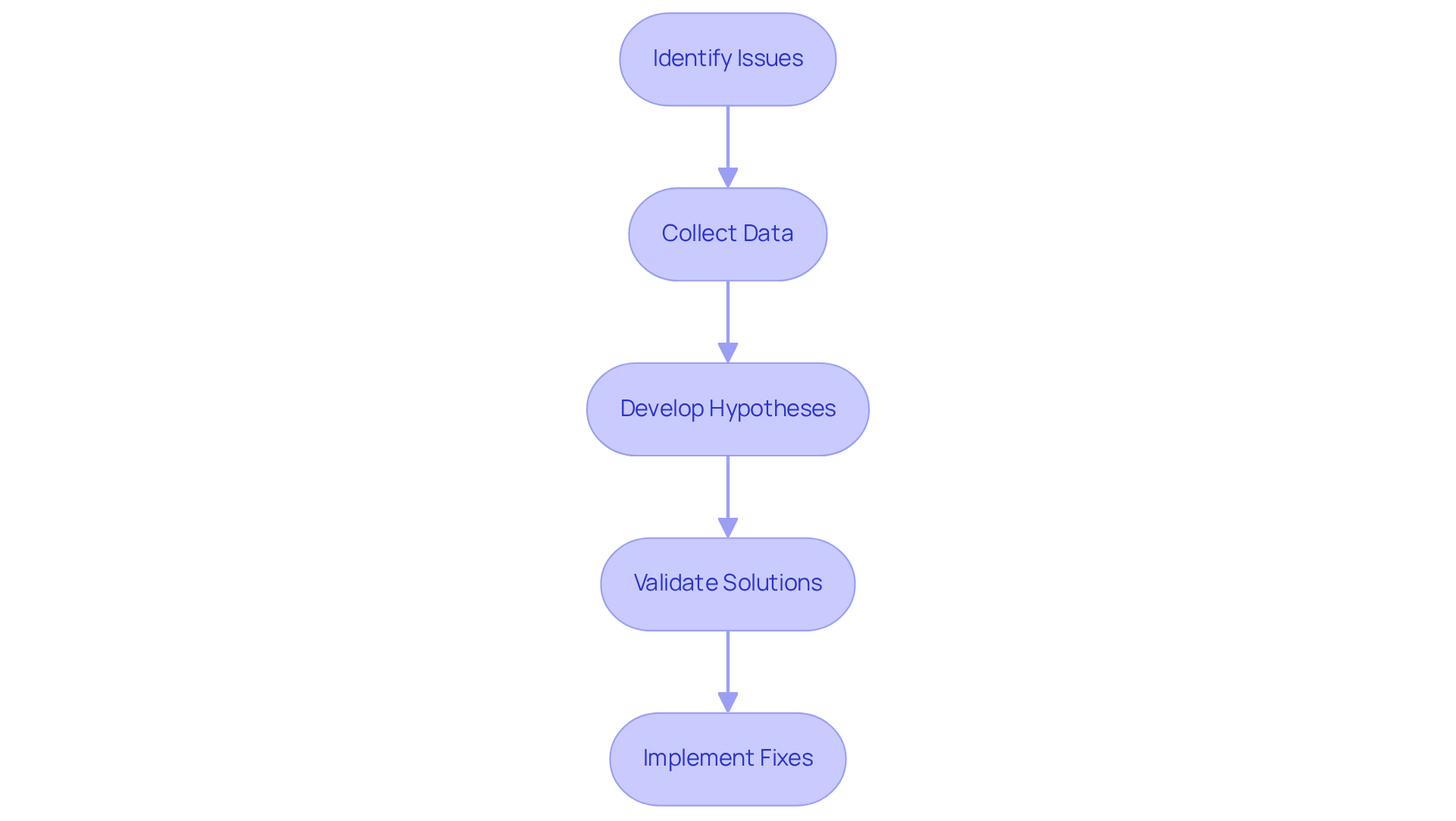
Instabug: AI-Driven App Issue Resolution
Coding challenges are a significant hurdle for developers today. This platform, Kodezi, utilizes AI bug repair to revolutionize the software development landscape by providing intelligent bug detection and automatic code correction capabilities. How does it do this? Kodezi's resource for AI bug repair autonomously analyzes bugs, corrects them, and offers explanations, significantly boosting productivity for programmers. This distinct method functions as an AI bug repair solution for code, enabling users to troubleshoot and resolve coding problems effectively. As a result, developers can experience a significant decrease in debugging time.
Furthermore, Kodezi is primarily designed to work with Visual Studio Code and offers AI bug repair support for over 30 programming languages. This software stands out from others like Copilot by focusing on AI bug repair rather than just code completion. The benefits of using Kodezi are clear: enhanced efficiency and improved code quality. Based on industry insights, AI-driven applications like Kodezi simplify the development process, providing effective AI bug repair and aligning with the growing demand for high-quality and responsive applications.
In addition, this instrument exemplifies how AI bug repair can transform software maintenance. As highlighted by industry leaders, AI-driven solutions such as Kodezi and AI bug repair are essential for improving code quality and ensuring smooth user experiences. Are you ready to explore the tools available on this platform? Discover how Kodezi can elevate your coding practices and enhance your productivity.
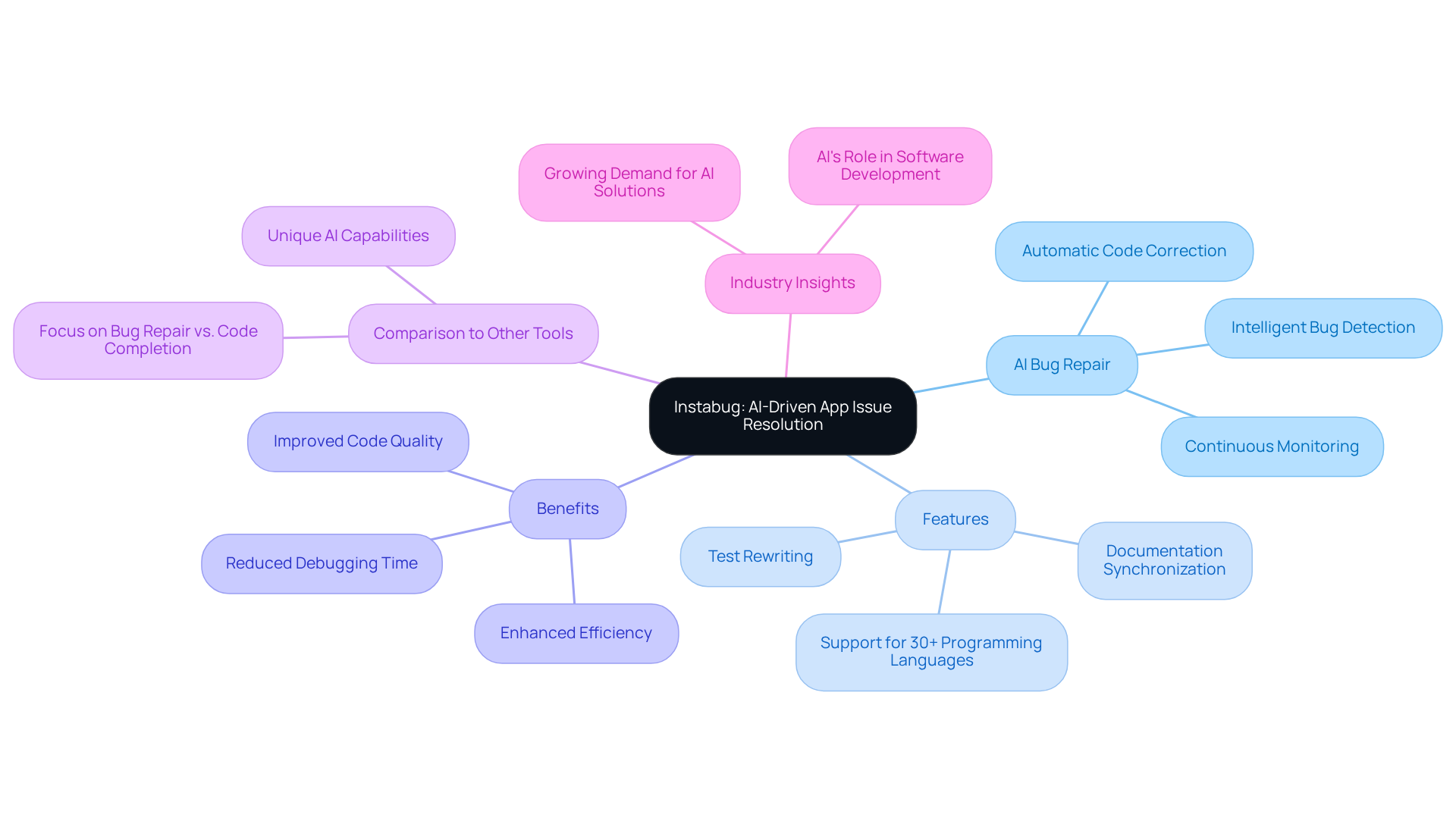
Generative AI: Cutting Debugging Time in Half
In today's fast-paced development environment, coding challenges can often impede progress and productivity. Generative AI applications, like Kodezi, are revolutionizing the debugging landscape through AI bug repair by significantly reducing the time required to identify and fix issues. By leveraging advanced algorithms and machine learning techniques, Kodezi examines code patterns and anticipates potential problems before they escalate.
Kodezi CLI serves as a versatile tool for B2B engineering teams, autonomously improving code quality and addressing issues prior to production. This AI-assisted development tool not only optimizes and formats code but also incorporates AI bug repair features, ultimately boosting developer productivity. With features such as CI/CD integration and a strong commitment to privacy protection, Kodezi CLI effectively uses AI bug repair to cut debugging time by fifty percent.
Imagine the impact of such efficiency on your projects. By using Kodezi, developers can focus more on innovation rather than getting bogged down by bugs. The result? A marked improvement in overall application quality. Explore the tools available on the Kodezi platform and experience the transformation in your development process.
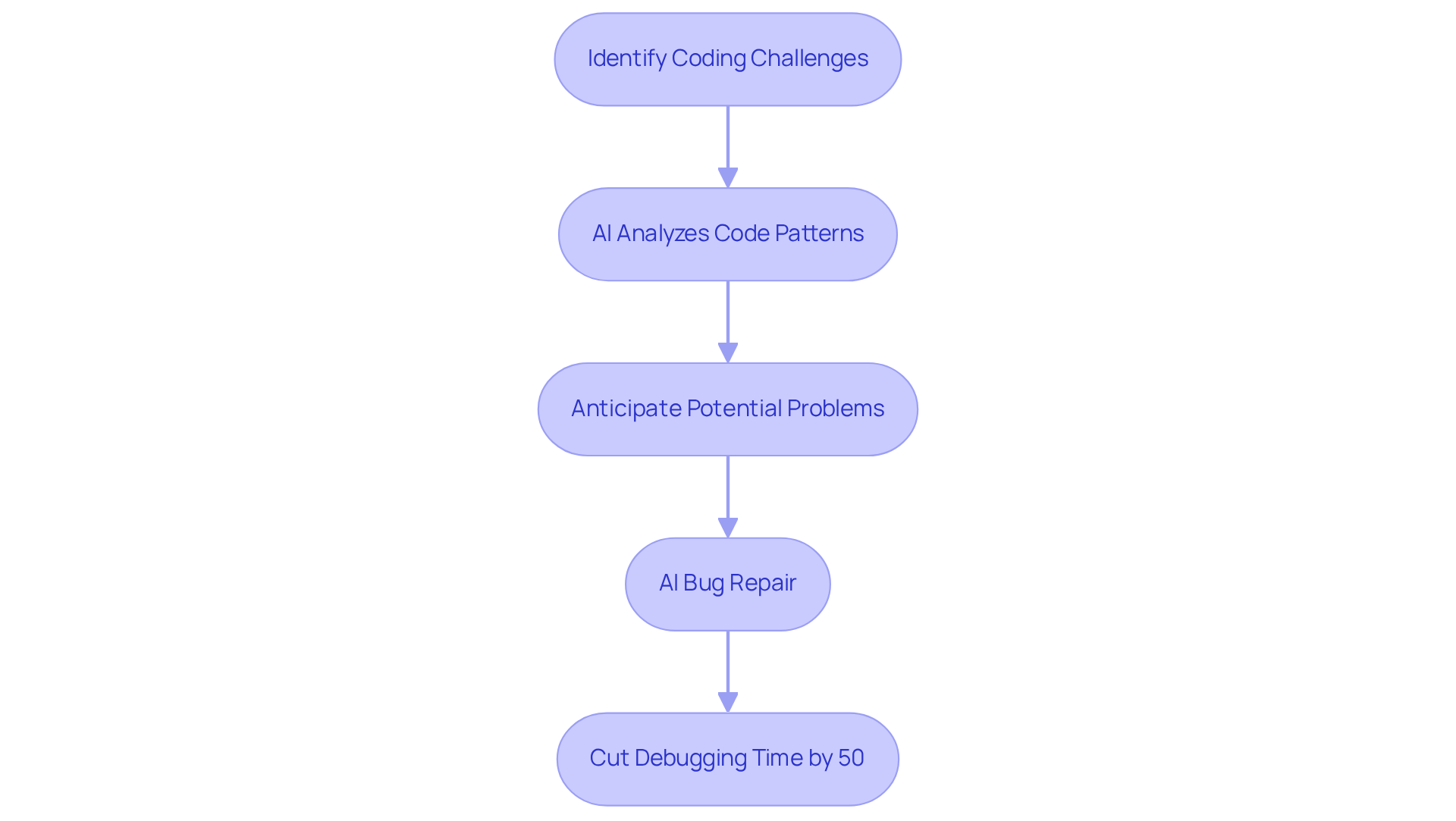
Google Research: AI-Powered Patching for Vulnerability Fixes
In today's digital landscape, developers face significant challenges with coding, particularly when it comes to managing vulnerabilities. Google Research has made notable advancements in utilizing AI bug repair for automated vulnerability patching, addressing these challenges head-on. Their AI-powered patching system leverages large language models to identify and remediate vulnerabilities in real-time. By examining code and historical data, this system can suggest effective patches, ensuring that applications remain secure and compliant.
This proactive strategy for vulnerability management illustrates how AI bug repair can enhance the security stance of software applications, rendering it an essential resource for developers. Notably, did you know that 60% of breaches are linked to unpatched vulnerabilities? This statistic underscores the critical need for effective patch management. Furthermore, adopting a risk-based approach to patch management, as emphasized by cybersecurity expert Chase Cunningham, can significantly reduce the risk of successful cyberattacks.
AI solutions also tackle difficulties encountered by IT and security departments. For instance, there is a 24% discord on patching cycles, and 61% of the time, external events initiate patch management activities. By incorporating AI bug repair into their workflows, developers can focus on innovation while maintaining strong security measures. They benefit from ongoing monitoring and visibility that AI/ML solutions offer.
Additionally, AI can predict vulnerabilities likely to be exploited within 30 days of disclosure, further enhancing its role in proactive vulnerability management. As developers, exploring these AI tools can lead to improved productivity and code quality, ultimately fortifying the security of your applications.
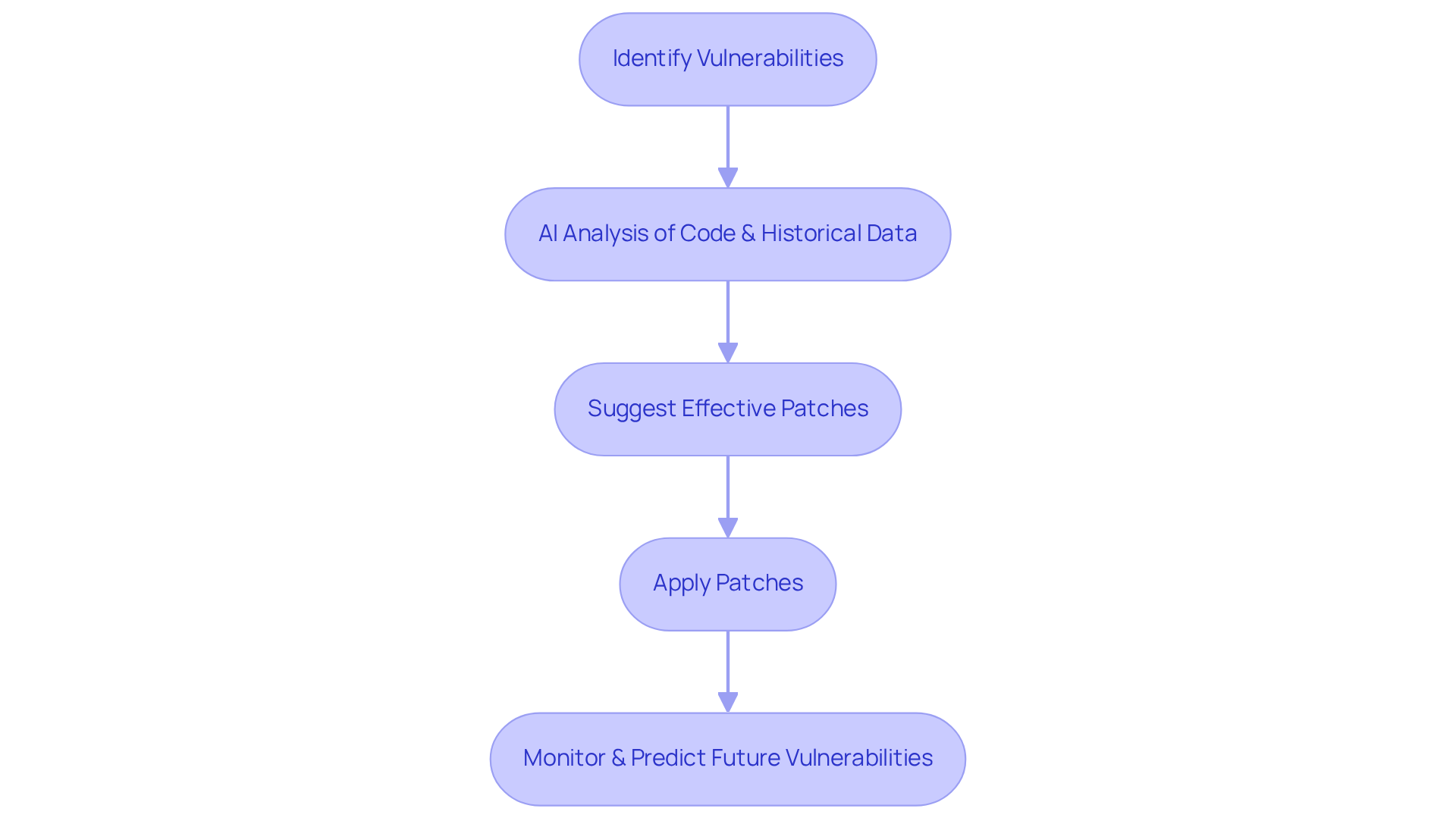
Facebook's SapFix: Automated Bug Fixing Workflow
Developers often grapple with significant coding challenges that can hinder productivity and code quality. How can these challenges be addressed effectively? Facebook's SapFix represents a groundbreaking advancement in automating the AI bug repair workflow, seamlessly transitioning from issue identification to proposing solutions. By integrating with Facebook's continuous integration and deployment systems, SapFix autonomously generates multiple potential solutions for specific issues. It evaluates their quality by checking for compilation errors and crash persistence, presenting these proposed fixes to engineers for their approval. This ensures a thorough validation process that is both autonomous and isolated from the larger codebase.
Furthermore, this end-to-end automation significantly accelerates the debugging process, with AI bug repair cutting down the median time from fault detection to publishing a fix to just 69 minutes. As a result, developers can redirect their efforts toward more strategic initiatives rather than getting bogged down in repetitive debugging tasks. The instrument exemplifies the transformative potential of AI bug repair in optimizing maintenance processes at scale, allowing engineering teams to manage technical debt more effectively while maintaining high code quality. In addition, Kodezi CLI serves as a versatile solution for B2B engineering teams, autonomously improving codebases and performing AI bug repair before they reach production. This capability enhances programming productivity, enabling developers to focus on innovation rather than routine maintenance.
Approximately three-quarters of Sapienz reports have resulted in fixes by developers, further illustrating the effectiveness of the integration between SapFix and Sapienz. As noted by the Facebook engineering team, "SapFix is replicating the kind of debugging work that people currently do, but it is not designed to deploy fixes to production code on its own." By leveraging these tools, developers can enhance their coding practices and ultimately improve their productivity and code quality.
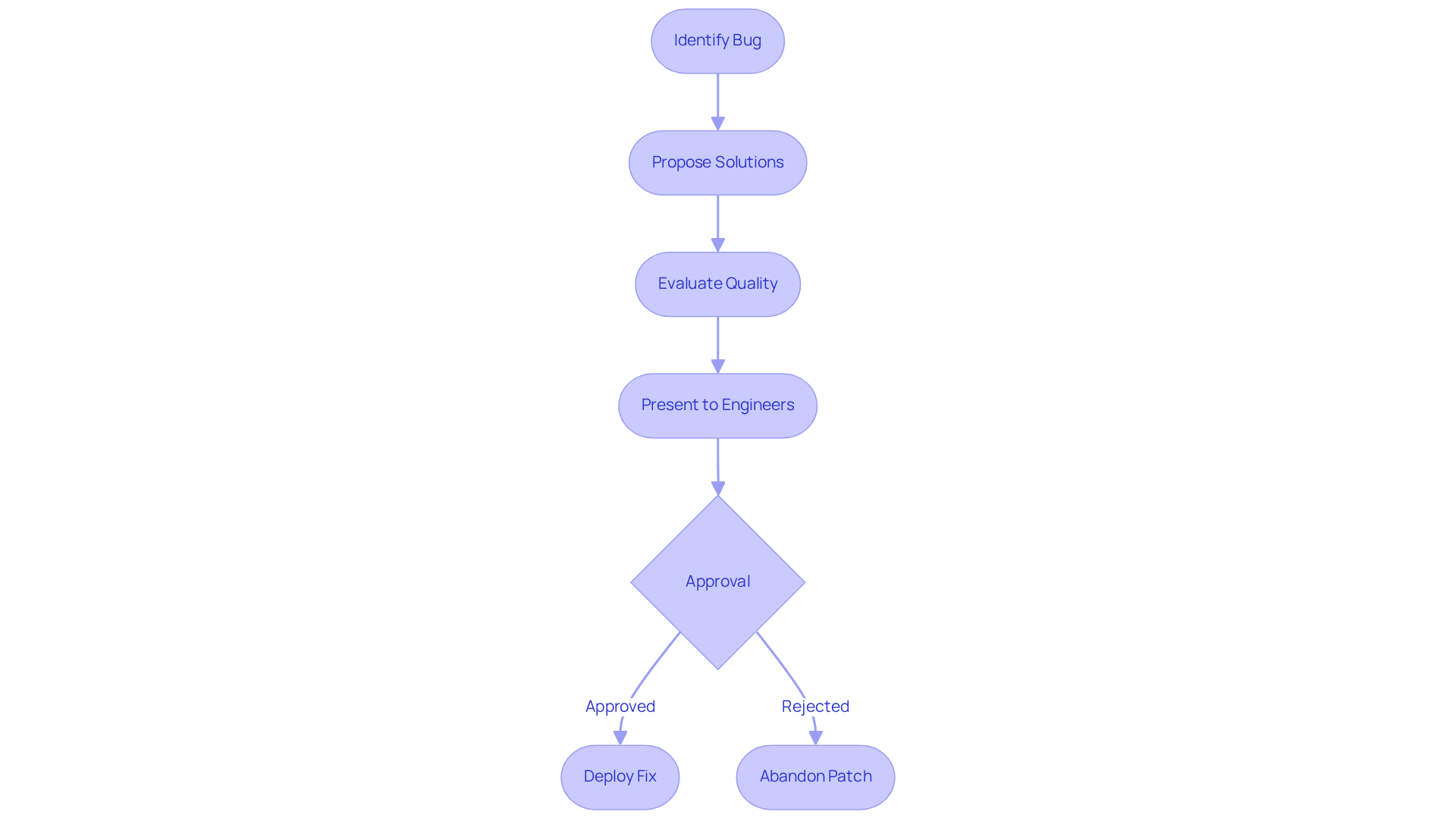
Amazon Science: AI for Automated Bug Localization and Repair
In the fast-paced world of software development, coding challenges can often hinder progress. How can developers streamline their debugging processes and enhance their code quality? Amazon Science has pioneered advanced AI resources designed for automated bug localization and AI bug repair, significantly improving maintenance efficiency. By utilizing large language models, these resources analyze code to pinpoint bug locations, thus enhancing the debugging process. This automation allows developers to address problems more quickly, resulting in a substantial decrease in downtime and an overall improvement in reliability.
Organizations that have adopted automated bug identification systems report an impressive average decrease in downtime of 41%. This statistic underscores the essential role these technologies play in contemporary software development. Furthermore, Kodezi exemplifies this trend by providing an AI-assisted development tool that not only automatically corrects code but also includes AI bug repair and optimizes programming efforts. With features such as bug healing and test healing, Kodezi enhances the maintenance process while ensuring user privacy protection.
As the sector transitions toward automation, these advancements highlight the growing reliance on AI bug repair to enhance maintenance practices. Kodezi stands as a valuable resource for developers of all levels, offering tools that can transform coding practices. Are you ready to explore how Kodezi can elevate your development experience?
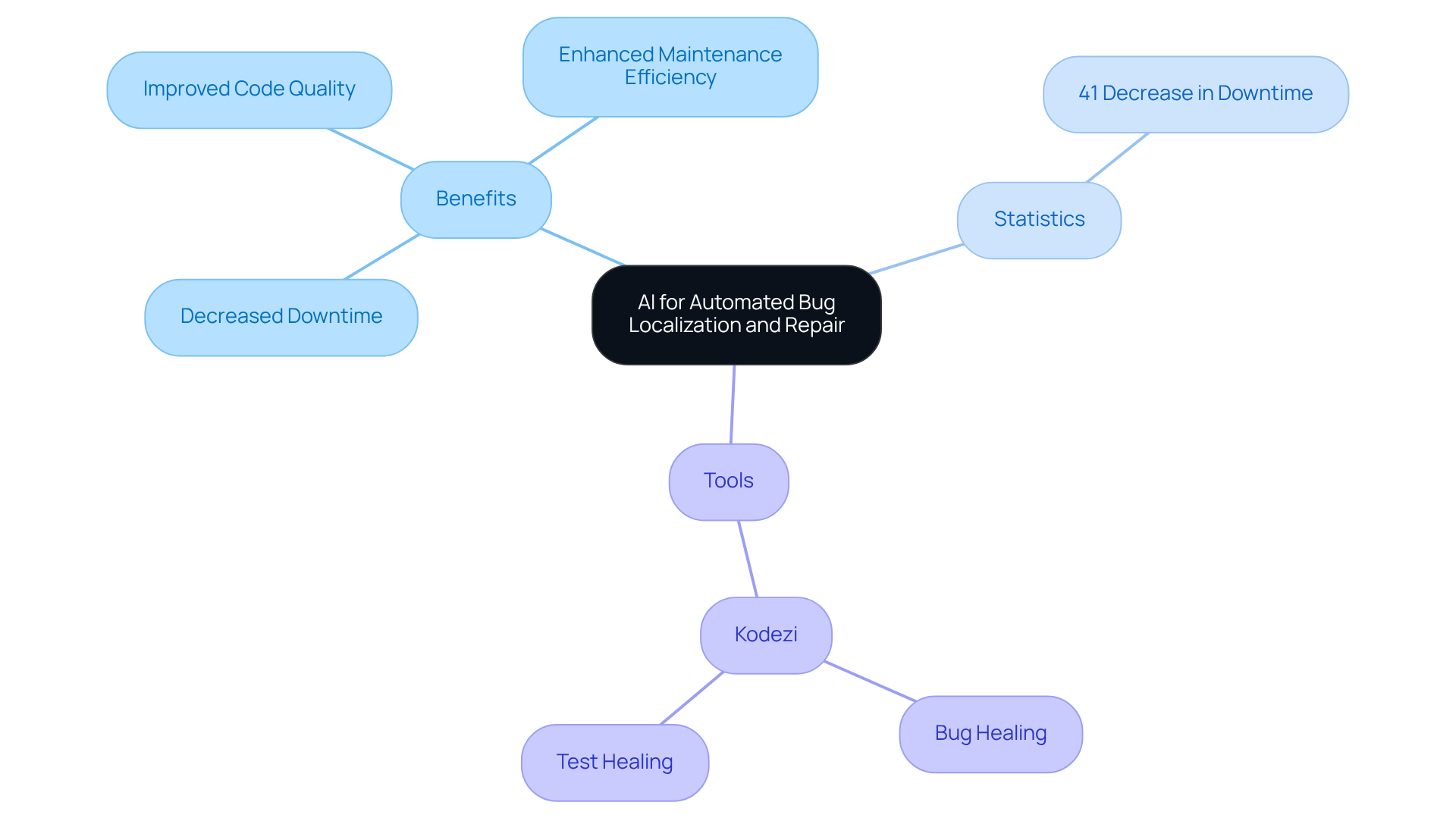
AI in Customer Service: Enhancing Software Maintenance Experience
Developers often face significant challenges in coding, particularly when it comes to debugging and maintaining software. Fortunately, Kodezi addresses these hurdles with its innovative features. With tools like automated code generation software, users can create complete coding projects simply by dragging and dropping PDF guidelines, streamlining the entire coding process. Additionally, KodeziChat, an AI-driven tool, facilitates the rapid resolution of coding questions and issues, enhancing productivity for over 1,000,000 users.
What benefits can you expect from using Kodezi? User testimonials reveal that the tool's AI bug repair capability has transformed debugging and programming efficiency, with many users noting a remarkable improvement in their ability to identify and resolve bugs swiftly. This proactive approach not only boosts user satisfaction—evidenced by the 68% of users who reported a positive experience due to its speed and effectiveness—but also provides valuable insights into application performance. These insights empower developers to make informed decisions regarding maintenance and enhancements.
By integrating AI into customer service and system maintenance, companies foster a more responsive and user-focused experience, ultimately enhancing customer loyalty and retention. Furthermore, companies utilizing AI resources report up to a 35% decrease in operational expenses, underscoring the effectiveness of these technologies.
Are you ready to explore the tools available on the Kodezi platform? Discover how these features can elevate your coding practices and improve your overall productivity.
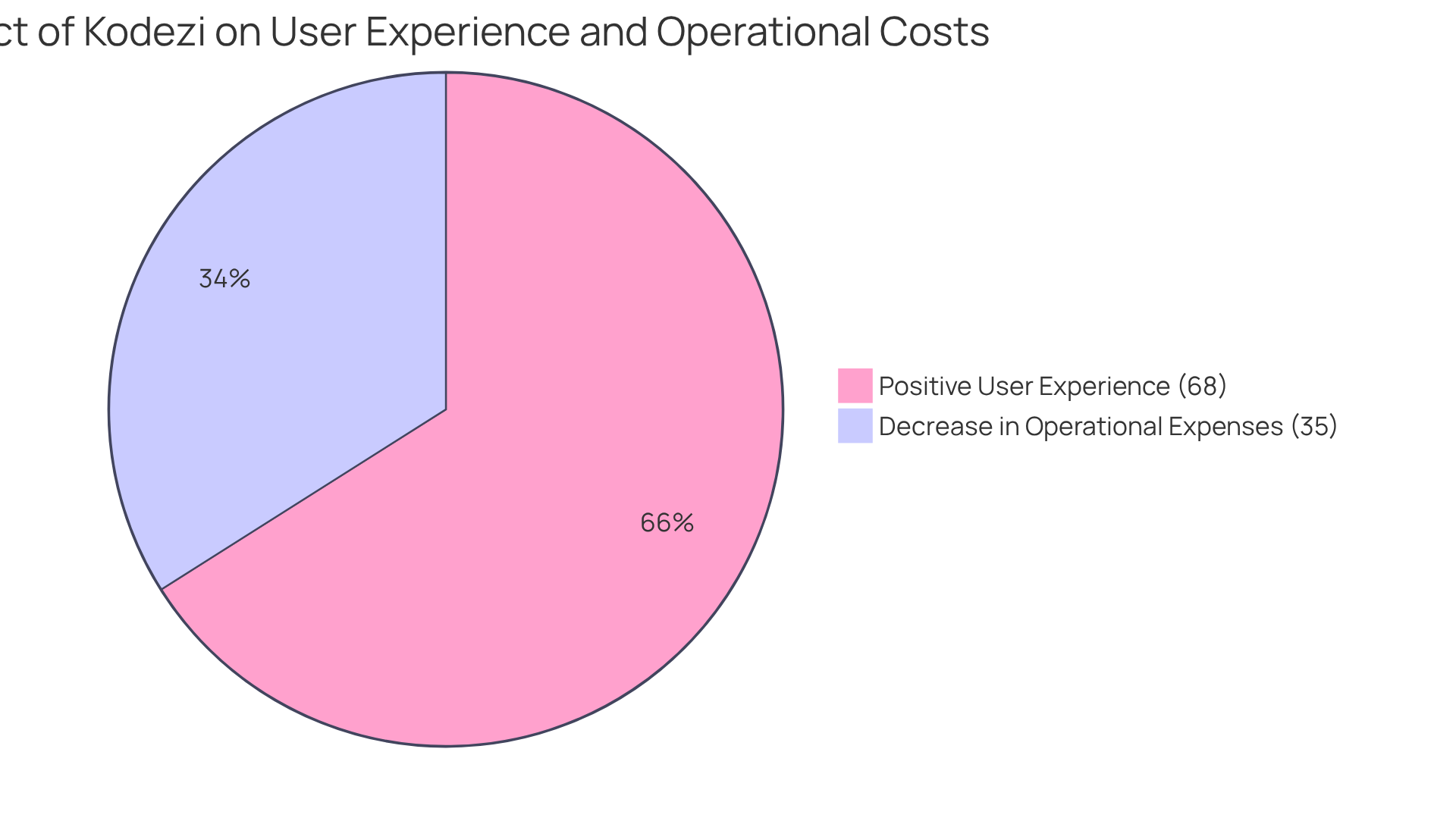
Challenges and Opportunities: AI in Software Repair
Coding challenges are a common hurdle that developers face today. AI applications for AI bug repair are transforming software repair by providing significant advantages, yet they also bring challenges that developers must skillfully handle. Kodezi addresses these challenges with its robust features. For instance, the CLI serves as a flexible solution for B2B engineering teams, independently enhancing codebases and addressing issues before they reach production. Furthermore, Kodezi automatically examines errors, offers explanations, and can enhance, transform, and produce comments on code. This distinguishes it from other tools like Copilot, which mainly concentrate on code completion.
The benefits of using Kodezi are noteworthy. While the accuracy of AI-generated fixes remains a primary concern—studies indicate that approximately 30% of AI-generated solutions require human oversight to ensure reliability—developers have reported that AI bug repair can significantly reduce debugging time by as much as 47%. However, it is crucial to monitor closely, as proper AI bug repair is necessary to prevent AI from inadvertently introducing new bugs if not overseen properly. Despite these challenges, the potential for enhanced efficiency and better quality is undeniable. By proactively addressing these issues, developers can utilize Kodezi's features to create more robust and maintainable systems, fostering innovation and enhancing overall productivity in the industry.
Kodezi is suitable for programmers at all levels, from beginners to professionals, looking to enhance their coding efficiency. As we approach 2025, the incorporation of AI in application maintenance is anticipated to grow, with 75% of large organizations adopting formal AI governance structures to manage these complexities efficiently. Are you ready to explore the tools available on the Kodezi platform to elevate your coding practices?
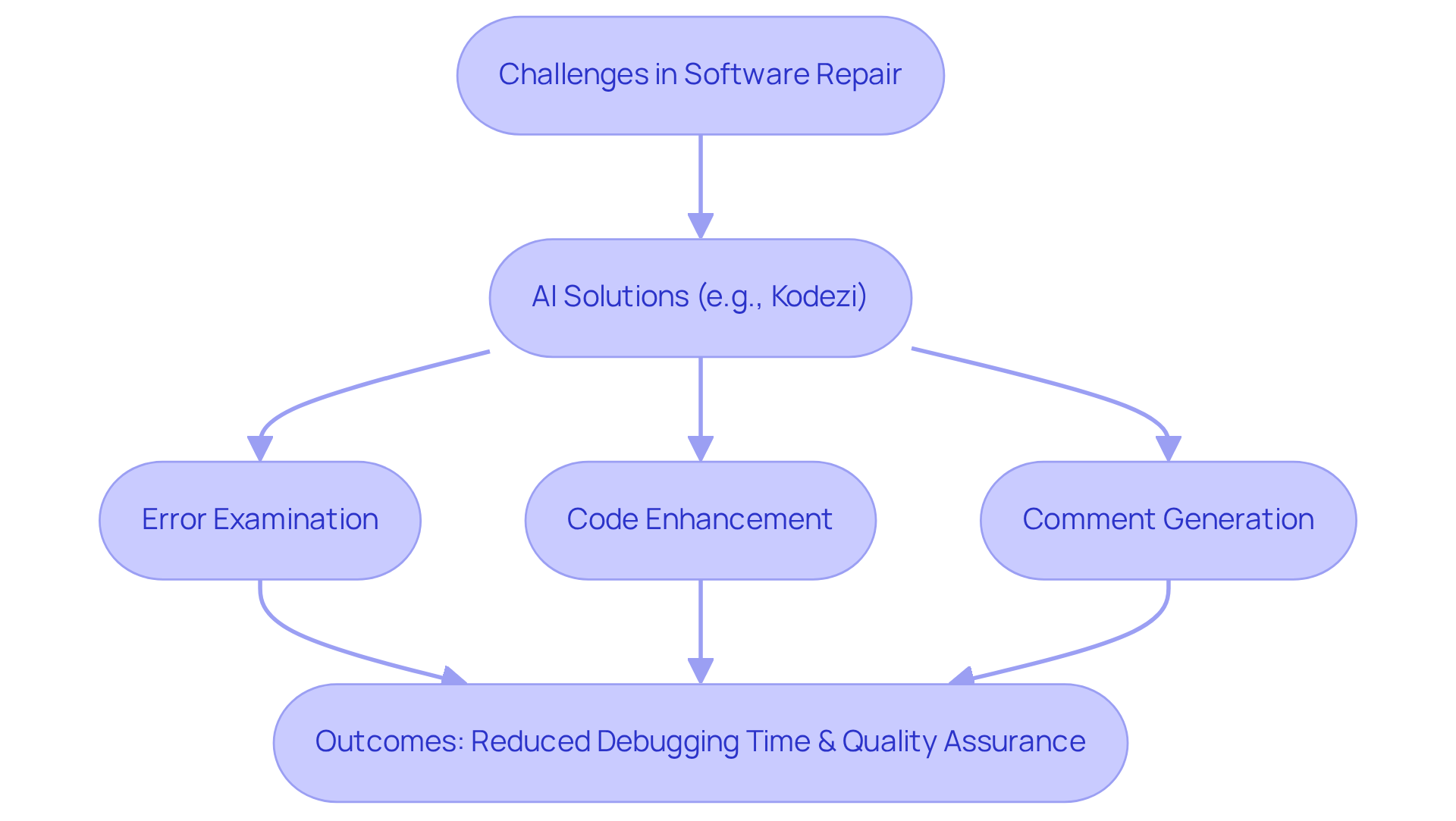
The Future of AI in Software Maintenance: Trends and Predictions
Coding challenges are a common hurdle for developers, often leading to frustration and inefficiencies. However, the future of AI bug repair in software maintenance promises remarkable advancements that can significantly alleviate these issues. Tools like Kodezi CLI exemplify this evolution, as they use AI bug repair to autonomously enhance codebases and resolve errors before they reach production. This proactive approach not only boosts programming productivity for B2B engineering teams but also transforms the development workflow.
Furthermore, as AI technologies mature, their integration into development processes will enhance real-time monitoring and automate responses to emerging challenges. Imagine having a tool that not only identifies issues but also resolves them, allowing developers to focus on higher-level strategic initiatives. The anticipated rise of generative AI is expected to further enhance the capabilities of existing resources, facilitating AI bug repair and enabling them to identify and resolve complex bugs more effectively.
In addition to improving quality, this evolution will redefine developer roles, fostering a more efficient and responsive environment. Industry leaders anticipate that by 2025, the adoption of autonomous systems in AI bug repair will considerably rise, with an expected growth rate exceeding 20% in the market for AI-driven tools and platforms. As organizations increasingly recognize the value of these innovations, the landscape of software development will continue to evolve.
For those interested in exploring Kodezi CLI, a 5-minute quickstart and demo are available to showcase its capabilities. Are you ready to enhance your coding practices and embrace the future of software maintenance?
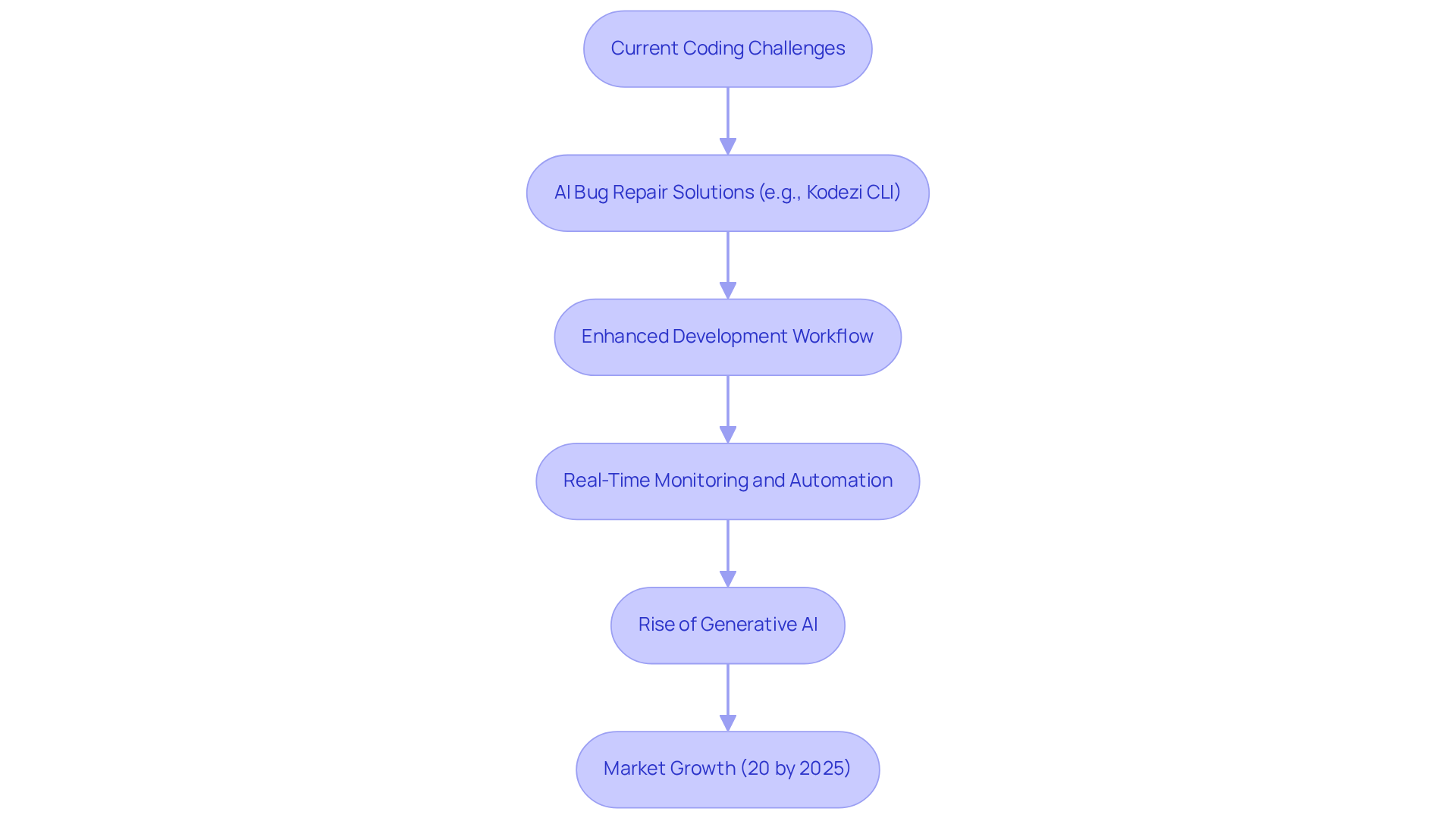
Conclusion
The landscape of software maintenance presents significant challenges for developers, particularly in debugging and code quality. Innovative AI bug repair tools, such as Kodezi, RepairAgent, and Instabug, are emerging as essential solutions to these issues. Kodezi, with its autonomous infrastructure for codebase maintenance, exemplifies how technology can streamline the debugging process. By automating tedious maintenance tasks, developers can redirect their focus towards more strategic initiatives, ultimately enhancing productivity and code quality.
These tools not only improve efficiency but also address persistent challenges in software development. For instance, Facebook's SapFix simplifies the bug-fixing workflow, demonstrating the unique features that each tool offers. Furthermore, proactive vulnerability management, as underscored by Google Research, highlights the critical role of these technologies in ensuring software security and reliability. As organizations increasingly adopt AI-driven solutions, the potential for improved code quality and reduced debugging time becomes evident.
As the industry evolves, embracing AI in software maintenance is not merely an option; it is a necessity. Developers are encouraged to explore these advanced tools and integrate them into their workflows. Engaging with innovations like Kodezi will not only streamline processes but also foster a culture of continuous improvement in an ever-evolving digital landscape. The future of software development is promising, with AI leading the charge to revolutionize how coding challenges are approached and resolved.
Frequently Asked Questions
What is Kodezi OS and what challenges does it address?
Kodezi OS is a command-line interface (CLI) designed for codebase maintenance and development. It addresses challenges such as debugging, documentation updates, bug repair, test healing, and security checks, streamlining post-coding tasks for developers.
How does Kodezi OS utilize AI for bug repair?
Kodezi OS employs AI bug repair to autonomously detect and fix issues in codebases as they arise. It continuously monitors codebases for entropy and risk zones, providing detailed explanations of problems and their resolutions.
What integrations does Kodezi OS support?
Kodezi OS integrates with platforms like GitHub and CI/CD pipelines, facilitating seamless upgrades and bug repairs, making it a vital tool for modern engineering teams.
What is RepairAgent and how does it function?
RepairAgent is an autonomous agent within Kodezi CLI that specializes in AI bug repair. It collects data on identified bugs, formulates hypotheses for solutions, and validates these solutions through iterative testing, effectively addressing complex issues across multiple lines and files.
Why is Kodezi CLI significant for developers?
Kodezi CLI is significant because it helps developers manage unresolved bugs effectively, particularly those that are difficult to reproduce. It enhances debugging efficiency and is increasingly essential in modern development environments.
What programming environments does Kodezi support?
Kodezi is primarily designed to work with Visual Studio Code and offers AI bug repair support for over 30 programming languages.
How does Kodezi differ from other coding tools like Copilot?
Unlike Copilot, which focuses on code completion, Kodezi emphasizes AI bug repair, providing intelligent bug detection and automatic code correction capabilities, thus significantly enhancing productivity and code quality.
Is there a way to experience Kodezi's capabilities?
Yes, there is a quickstart demo available for users interested in exploring Kodezi's features and capabilities, allowing them to see how it can transform their coding practices.




